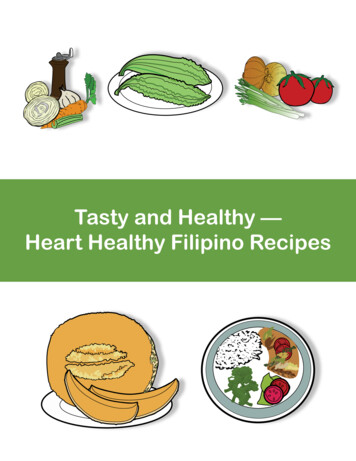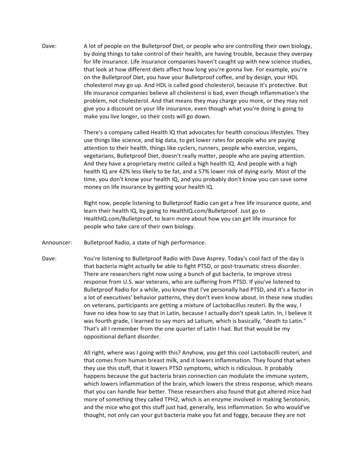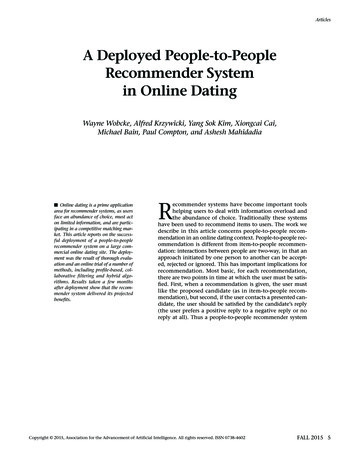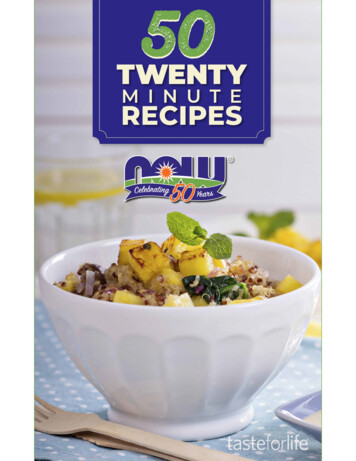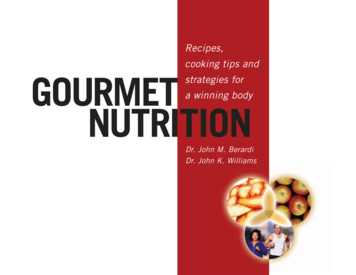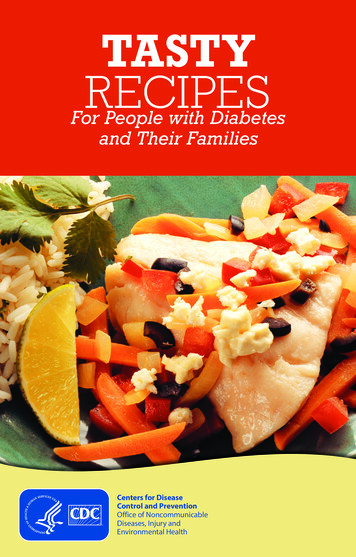
Transcription
TASTYRECIPESFor People with Diabetesand Their FamiliesCenters for DiseaseControl and PreventionOffice of NoncommunicableDiseases, Injury andEnvironmental Health
Ask your healthcare provider to refer you todiabetes self-management education and support services.To find an American Diabetes Association-recognized or anAmerican Association of Diabetes Educator-accrediteddiabetes program in your area, s/find-an-education-program2
I Have Diabetes.What Do I Need to KnowAbout Healthy Eating?You can take good care of yourself and your diabetes by learning abouthealthy eating—what foods to eat, how much to eat, and when to eat.Healthy eating can help keep your diabetes under control and loweryour risk for heart disease, stroke, and other health problems caused bydiabetes. Making wise food choices will help you feel good every day andlose weight if needed.This recipe booklet will help you create healthy meals and learn how tofollow a healthy eating plan. A healthy eating plan contains many of thefoods and beverages you usually eat or drink. Foods fit together like puzzlepieces (see Figure 1) to meet your health needs without going over yourcalorie limits. Your calorie intake depends on the total calories in your food,which includes your saturated and non-saturated fats, added sugars, andcarbohydrates. All kinds of foods, including fresh, canned, dried, and frozenfoods—including special treats—can be included in a healthy eating plan.Whether you have been diagnosed with type 1, type 2, or gestationaldiabetes, understanding how foods and nutrition affect your body andtaking steps to stay healthy will help you manage it successfully.Figure 1: A Healthy Eating PlanProteinWaterWholeGrainsPortionControlFruits andVegetables3
Your Diabetes ABCsA stands for A1C test. This test measures your averageblood glucose levels for the past 3 months. Your doctorshould test your A1C at least twice a year. The A1C goalfor many people with diabetes is below 7. It may bedifferent for you. Ask what your goal should be.B stands for blood pressure, a measurement of howhard your heart needs to work to keep your bloodcirculating. For most people with diabetes, the goal is tokeep blood pressure below 140/90.C stands for cholesterol, a fat found in your blood.There are two kinds of cholesterol in your blood: LDL andHDL. LDL or “bad” cholesterol can build up and clog yourblood vessels. It can cause a heart attack or stroke. HDLor “good” cholesterol helps remove the “bad” cholesterolfrom your blood vessels.Ask your doctor what you can do to reach your targets forA1C, blood pressure, and cholesterol.4
Take steps to manage your diabetes Ask your doctor how often you should check your blood sugar. Learn how to keep your blood sugar in your target range. Ask yourdoctor about the best range for you. Know your diabetes ABCs (see the call out on the previous page). Ask your doctor for an A1C test at least twice a year. Talk to your doctor about how to plan your meals around taking yourmedication and being physically active to stabilize your blood sugar. If you are taking insulin, your meals need to be planned around yourmedications. If you don’t eat or eat later than planned, you maydevelop low blood sugar (hypoglycemia). In contrast, eating too much food may cause your blood sugar levelto climb too high (hyperglycemia).Learn how to keep your blood sugar on targetYou can prevent health problems by keeping your blood sugar in your targetrange. Ask your health care team to suggest a blood sugar target rangefor you. Healthful eating can keep your blood sugar levels on target. Beingphysically active and taking your diabetes medicines can also help.Make wise food choices and develop healthy eating habitsRead the Nutrition Facts labelsYou can learn how healthy a food is by readingthe label (see Figure 2). For help, ask a dietitian ora diabetes educator. Try to eat less of foods highin saturated fat, trans fat (liquid oils turned intosolid fats during food processing), added sugar,and salt.Figure 2: How to Understanda Nutrition Facts LabelNutrition Facts8 servings per containerServing size2/3 cup (55g)Amount per serving230Calories% Daily Value*Total Fat 8gSaturated Fat 1gTotal Carbohydrate 37gDietary Fiber 4g To learn more about how to read the NutritionFacts label so you can make smarter foodchoices, visit the FDA for Consumerswebsite cm387114.htm).10%5%Trans Fat 0gCholesterol 0mgSodium 160mg0%7%13%14%Total Sugars 12gIncludes 10g Added SugarsProtein 3g20%Vitamin D 2mcg10%Iron 8mg45%Calcium 260mgPotassium 235mg20%6%* The % Daily Value (DV) tells you how much a nutrient ina serving of food contributes to a daily diet. 2,000 caloriesa day is used for general nutrition advice. To find a diabetes educator, visit the American Association of DiabetesEducators website /find-a-diabetes-educator). To find a dietitian, visit the Academy of Nutrition and Dietetics website(https://www.eatright.org).5
Develop a healthy eating planMake an appointment with a dietitian as soon as you find out you havediabetes or if you have had diabetes for a while but don’t have a mealplan. Your dietitian will teach you about healthy food choices, portionplanning, and help you make a meal plan that works for you. Your dietitianshould review your meal plan at least once a year. Discuss how to make ahealthy eating plan work with the foods you like, your daily routine, and anymedicines you take.Check serving sizes on the Nutrition Facts labelIt is easy to eat more food than you need without realizing it. A dietitian ora diabetes educator can show you simple ways to learn the right servingsize for you without overeating. A serving size is a fixed amount, a standardamount that is used to measure foods (for example, one cup, one part orone ounce), and is also a unit of measure for food. For example, a servingof protein, such as chicken or fish, is the size of a deck of cards or thepalm of your hand. A portion is the amount that you choose to drink orto eat. A dietitian can help you make a daily meal plan that will keepyou satisfied without overeating. There are many factors that affect yourpersonal meal plan. A dietitian or diabetes educator is specially trained tohelp you make the best plan for you. See Figures 3 through 5 (pages 10,11, and 12), to help you manage your portions and visually estimate howmuch you are eating.Manage your meal plan with the Nutrition Facts labelUsing the Nutrition Facts label, you can compare the salt content of foodsand choose the product with less salt. Use the Nutrition Facts label and ingredients list on the package tofind the amounts of saturated fat, salt, and added sugars in the foodsand beverages you choose. Look for foods and drinks that are lower insaturated fat, salt, and added sugar.6
Make healthy food choicesExamples of healthy food choices: Non-starchy vegetables such as chilies, nopales, jalapeños, carrots,cabbage, eggplant, cauliflower, broccoli, spinach, jicama, kale, lettuce,tomatoes, and peppers. Starchy vegetables such as potatoes, green peas, corn, acorn squash,butternut squash, pumpkin, plantains, yams, yuca, ñame, yautía,(malanga, camote, and batata); eat less of these foods because theyhave more carbs that will raise your blood sugar. Dried beans, dried peas, and lentils such as black and pinto beans,black-eyed and split peas. Whole grains such as whole wheat bread, oatmeal, brown rice, quinoa,whole wheat pasta, whole grain corn, cornmeal, and popcorn. Fruits, especially whole fruits. Fresh or frozen fruits are also goodchoices, but avoid fruit that is dried or canned or fruit juices becauseof the high sugar content. If you eat canned fruit, choose thosepacked in their own juice rather than syrup. Fat-free or low-fat dairy, including milk, yogurt, cheese, soft margarinewith zero trans fats, and fortified soy beverages. A variety of protein, including lean meats, poultry/chicken, turkey, fish,seafood, eggs, nuts, seeds, and soy products. Trim fat from meats,and remove the skin from poultry. Oils, such as olive, canola, and safflower. Avoid lard and shortening. Drinks with no added sugars, such as water, unsweetened tea,and coffee.7
Don’t skip mealsSkipping a meal can make you very hungry and make it easy to eat toomuch at the next meal so you take in more total calories for the day. Besure to space your meals evenly through the day. Work with your dietitianor health care team to find the best meal plan for you. Include a varietyof healthy, low-fat, and low-calorie foods. Remember that eating too littlecould result in hypoglycemia (low blood sugar).Learn how carbs affect your blood sugarCarbs are found in many foods and drinks, including bread, pasta, fruit,desserts, dairy products, sodas, juices, and starchy vegetables likepotatoes and corn. Complex carbs, such as whole grain bread and wholegrain pasta, provide more nutrition than other carbs. Cut back on sweetssuch as cake, cookies, and pies. Sweets are high in fat, calories, and carbs,so save them for a special treat once in a while.Knowing where you are getting carbohydrates, not only in what you eat, cangive key information to help you manage your blood sugar. Your dietitian canguide you on how many carbs to aim for at each meal. Foods high in carbshave the biggest effect on your blood sugar. It's important for people takinginsulin at mealtime to know how many carbs are in the foods they eat anddrink. Knowing the number of carbs you are eating helps you estimate thecorrect dose of insulin. Some examples of foods high in carbs are: Bread, pretzels, crackers, and tortillas. Pasta, noodles. Rice, cereal. Corn. Beans and lentils. Yams, yuca, and other root vegetables, such as potatoes, ñame,yautía, malanga, and camote, (batata). Green bananas or plantains.8
Reduce added sugars, saturated fats, and salt, and drinkalcohol in moderation or not at all Limit fruit drinks and sodas, or coffee or tea sweetened with sugarand honey. The two main sources of added sugars are sugary drinks such assodas and sweet snacks such as ice cream, cookies, and cakes. Watch out for hidden sugar, like tomato sauces, fat-free saladdressings, and condiments. Most of the sodium Americans eat comes from packaged, processed,store-bought, and restaurant foods. Only a small amount comesfrom salt added during cooking or at the table. Foods that come incans including beans, vegetables, soups and other processed foods,such as canned and instant soups, processed meats (such as coldcuts), and canned beans have high levels of salt. Rinsing beans andvegetables and eating fewer canned foods can help you maintain bloodpressure at normal levels. Also, use less salt when you cook, and takethe salt shaker off the table to avoid using it during your meal. Saturated fat is solid at room temperature and is most often found inanimal products (high-fat meat and dairy foods), some fried and bakedfoods, and palm and coconut oils. Reduce saturated fats. These fats come from burgers, sandwiches,tacos, pizza, and mixed dishes that contain meat or cheese or both(such as rice, pasta, and grain dishes with meat or cheese; and meat,poultry, and seafood dishes with cheese). Limit alcohol if you drink. That means no more than one drink per dayfor women and two drinks per day for men. For those who choose todrink, small amounts of alcohol can fit into most healthy eating plans.Keep in mind that drinking alcohol may increase your risk for lowblood sugar, especially if you are taking insulin or diabetes medicines.9
3)Figure 3: Use these pictures to estimate the portion size of foods you eat.These tools can serve as a good guide, but may not be exact enough for dosing insulin.Your fist is a handy tool thatis always with you. Placeyour fist on these outlinesto see how it compares to ameasuring cup.This fist 1 cupPLACEYOUR FISTHERE TOCOMPAREThis fist 11/2 cupsPLACEYOUR FISTHERE TOCOMPAREMy fist cups 2018 American Diabetes Association American Diabetes Association 201810
Figure 4: All fats are high in calories, so keep the portion size small(less than 1 tablespoon in most cases).EAT OFTENOil-based salad dressing: vinaigrette,oil and vinegarOils: canola, olive, sunflower, peanutTrans fat-free spreadsAvocado, olives, seeds, peanut oralmond butterSOMETIMESLow-fat creamy salad dressing likelight ranchOils: corn, soybean, safflower, sesameMayonnaiseLIMITFull-fat creamy salad dressing like ranchor blue cheeseButter, lard, coconut oilMargarineCream American Diabetes Association 201811
Figure 5: Use these pictures to estimate portion size of foods you eat.These tools can serve as a good guide, but may not be exact enough for dosing insulin.1 ozA serving of 23 almondsis about 1 ounce andabout 170 calories.Compare your piece of fruitto this apple to estimate thecalories and carbohydrates.A “small” piece of fruit is about21/2 inches in diameter andwill be about 60 calories and15 grams of carbohydrate.1 tspHow does this compare to howmuch you use in cooking?One teaspoon of olive oilgoes a long way.1 TbspHow does your portion compare?Salad dressing: Two tablespoonsare the standard serving size(if you want to cut calories, use less). American Diabetes Association 201812
Understand the difference between portions and servingsA portion is how much food you choose to eat at one time, for example,from a served meal in a restaurant or from a package at home.A serving size is the amount of food listed on a Nutrition Facts label. Aserving size on a food label may be more or less than the amount of oneserving. How much you eat depends on what else you are eating, yourage and weight, whether you are male or female, and how active you are.Sometimes portion and serving
RECIPES For People with Diabetes and Their Families Centers for Disease Control and Prevention Office of Noncommunicable Diseases, Injury and Environmental Health. 2
